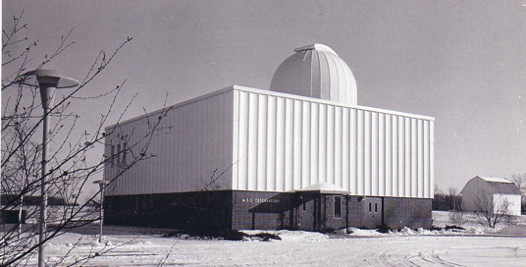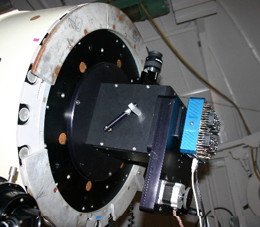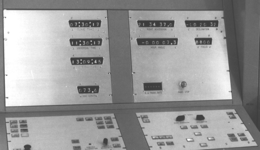
History of the observatory
compiled by MSU Professor Emeritus Horace Smith
July 2008
The first observatory at what was then the Michigan Agricultural College was built about 1881, and housed a 5 1/2 inch refracting telescope made by Alvan Clark and Sons. That telescope is on exhibit at Abrams Planetarium, but the first observatory had long been gone when the current campus observatory was constructed under the supervision of the then Chairperson of the Department of Astronomy, Albert Linnell. The observatory building was mostly completed in 1969, with the installation of the 24-inch Ritchey-Chretien reflecting telescope, built by the Boller & Chivens division of the Perkin-Elmer Corporation, following in 1970. The Boller & Chivens company built many similar sized telescopes in the 1960s and 70s, but the Michigan State University telescope was one of only a few to be equipped with a coude focus option, as well as the usual focus behind the primary mirror. The six-inch refracting telescope, on the same mounting as the 24-inch, was installed at the same time as the larger telescope. The observatory was officially dedicated in 1971. In 1974, the addition of a Raytheon computer allowed the telescope to be fully computer controlled. At the time of its construction, the site of the observatory, on agricultural land south of the main campus, was still relatively dark, and free of the light pollution present on the busier parts of the campus.
When the observatory was designed, it was anticipated that single channel photoelectric photometry of eclipsing binary stars would be one of its chief uses. It was also used for direct photography. Plans to equip the observatory with a 40-inch feed telescope never came to fruition. Although several research programs were begun, the observatory was closed in 1981, during a time of economic difficulty for Michigan State University and for the State of Michigan. It was at that time, too, that the then separate Department of Astronomy merged with the Department of Physics to become the current Department of Physics and Astronomy.

The observatory was reopened in 1986, in time for large crowds to observe Comet Halley that spring. Soon thereafter the telescope was equipped with the first of the series of CCD cameras (seen at right) that have been its main scientific tool since that time. Observations of variable stars were again a main focus of the research at the observatory. However, reflecting the interests of new faculty, pulsating variable stars rather than eclipsing variables became the main targets of observation. The telescope also remained in use for student observations, senior theses, and public outreach. Between 1986 and 2008, approximately 32,000 members of the general public attended one or another of the observatory open house nights. Besides Comet Halley, the well-publicized close approach of Mars in 2003 brought large crowds to the observatory grounds.
The growth of the Greater Lansing area and the construction of the adjoining Pavilion for Agricultural and Livestock Education brought increased light pollution to the observatory location by the middle 1990s. Nonetheless, by concentrating upon variable stars that were not too faint, the telescope remained scientifically productive.

As the observatory approached its 34th birthday, it was in regular use despite the increased light pollution in its neighborhood and the increased attention focused on the new SOAR telescope in Chile. It was, however, showing its age. While the telescope optics, tube, and gearing were basically fine, areas of the dome were rusting, the telescope's coordinate display did not always work (especially in cold weather), the Raytheon computer system (seen at right) was gone, and there was no up-to-date computer-driven operating system. In 2004, a grant obtained under the National Science Foundation's PREST program, supplemented by modest departmental funds, allowed a renovation of the observatory. Peter Mack, of Astronomical Consulting and Equipment, updated the telescope and installed a new operating system in the fall of 2005. In the spring of 2006, the dome was repainted and repaired. It is hoped that the telescope is now ready to remain in operation for years to come.


